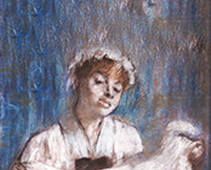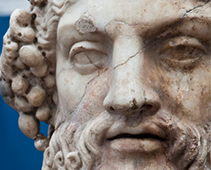The Glyptotek’s Rodin collection is unique outside of France. It contains such major works as “The Kiss”, “The Thinker” and the monumental “Burghers of Calais”
RODIN
Auguste Rodin
The Glyptotek’s Rodin collection is unique outside of France. It contains such major works as “The Kiss”, “The Thinker” and the monumental “Burghers of Calais”.
Auguste Rodin (1840-1917) is often seen as the rebellious forefather of modern sculpture, but in fact he raised no conscious revolt against the sculpture of his day. Rodin struggled for academic recognition but never managed to pass the entrance examination to the Academy of Arts in Paris.
Instead he was self-taught and developed a unique method for the modelling of complex forms in clay and plaster. Many of his most famous works were criticised in his lifetime. They broke with a tradition of idealised, decorative sculpture with little room to manoeuvre in how mythological or literary subjects could be presented. Rodin’s distinguishing characteristic is a realistic but expressive modelling of the body together with a great sense of the symbolic content of the motif. Slowly he attained popularity and achieved his decisive breakthrough at the World Exposition in Paris in 1900.
Carl Jacobsen, the founder of the Glyptotek, saw Rodin’s masterpiece “The Thinker” at the French Exhibition in Copenhagen in 1888, and from 1900 he began to buy works directly from the artist whom he liked to visit in Paris. Jacobsen’s collection of 24 sculptures has since grown to 43.




